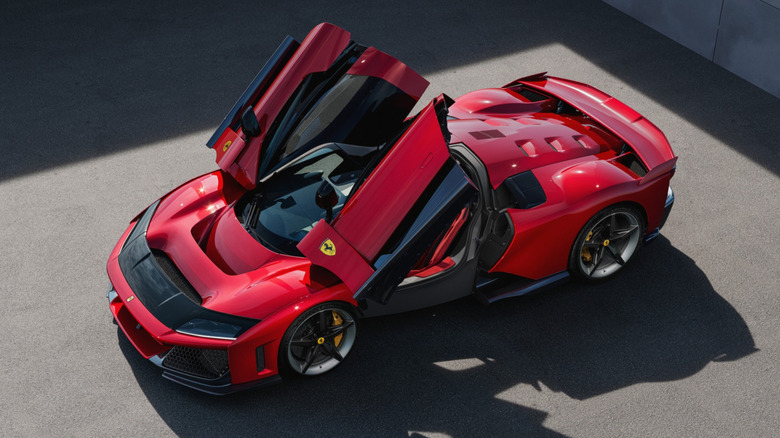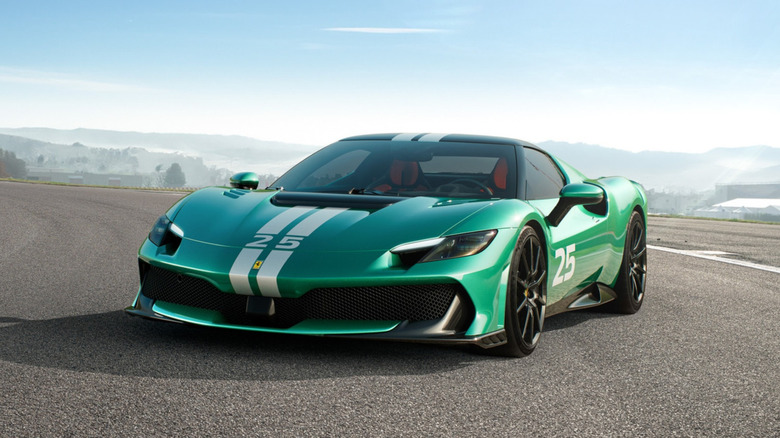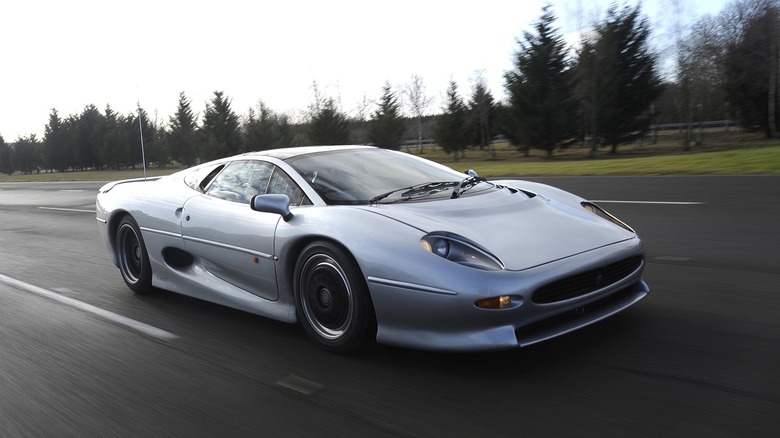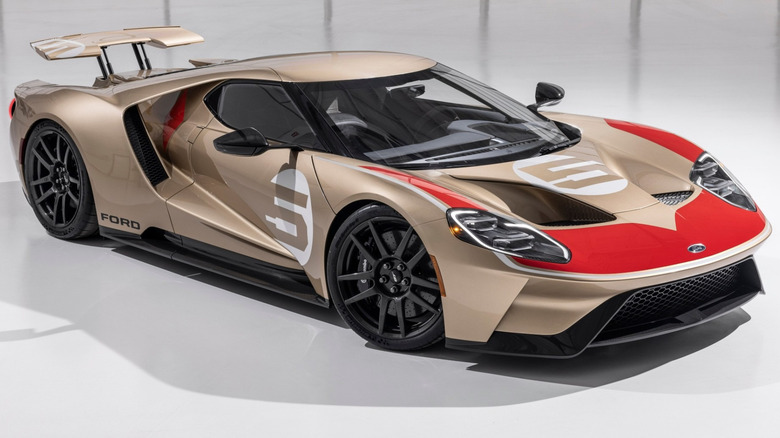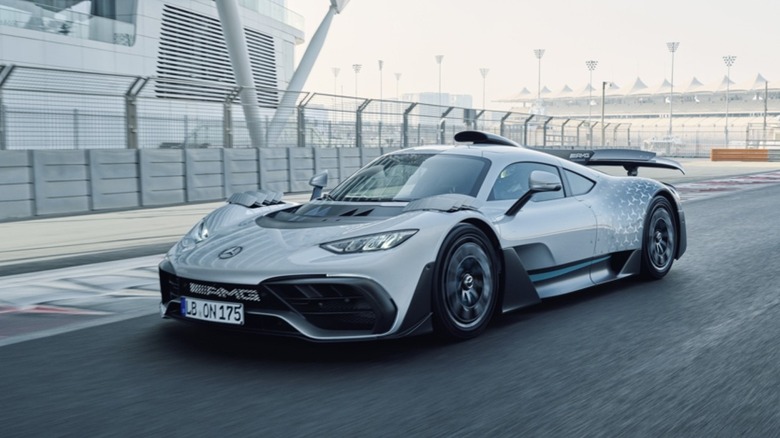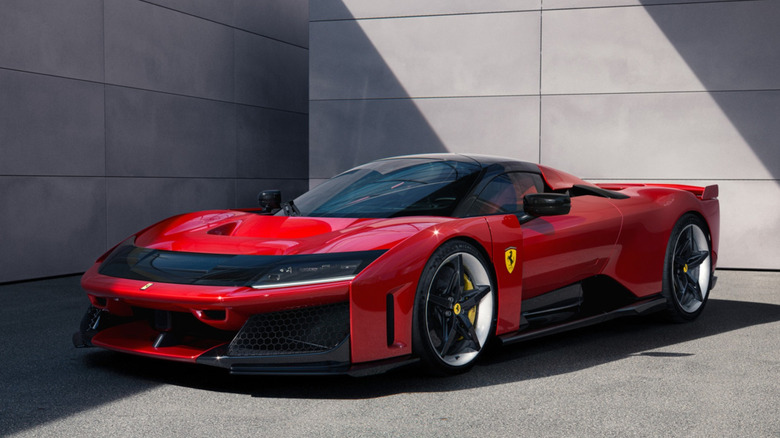5 Of The Fastest V6 Cars, Ranked By Speed
Ever since Lancia launched the Aurelia, the world's first V6 production car in 1950, the V6 has been on an upward trend of popularity. Thanks to its compact footprint and smooth operation, the V6 was installed in every type of vehicle imaginable. The Golf R once had a V6. Same for the S-Class. Even Mazda made a tiny 1.8-liter V6 engine!
But few would think that the V6 could be mentioned in the same sentence with supercars. Still, in an era when world-leading automaker Toyota is quietly moving away from the V6 engine in favor of turbocharged inline-4s, supercar manufacturers are replacing their V8 and V12 behemoths with tiny V6s. Treacherous, we know. But the thing is — the speedometer needle has reached new heights recently, energized by a V6 engine.
Hard to believe, huh? That's exactly why we made this list of the fastest V6 cars. Yes, electricity aids some of them, but we won't complain if it hits 200 mph. Besides, the electrons are there to give you more speed — not just efficiency. How much speed? Well, here is a spoiler for you — each of these cars easily breaks the 200 mph barrier.
2025 Ferrari 296 Speciale (0-60: 2.8 seconds, 205+ mph)
The funny thing about the 296 Speciale is that it only sits in the middle of Ferrari's current mid-engine lineup. Yet, it accelerates to 60 in 2.8 seconds — an astonishingly impressive feat for a rear-wheel-drive car. In fact, Ferrari says this is the limit of what a rear wheel drive machine can achieve because of traction issues.
Things get even more impressive as you accelerate further, with the 296 Speciale reaching over 205 mph, despite delivering 959 pounds of downforce at 155 mph. Why so much downforce? Well, this is the hardcore, track-oriented version of the 296 GTB. Apart from having more aggressive aero, the Speciale has also been treated to extensive weight reduction, resulting in a 132-pound lower curb weight.
Still, Ferrari has achieved most of the weight savings where it really matters — inside the engine. The Prancing Horse engineers slimmed the crankshaft down by 4.8 pounds, while removing weight from the block and crankcase to remove a further 2.6 pounds. Titanium screws also replaced the steel screws in the 296 GTB, and a new, lighter turbo was installed.
All this resulted in a much more responsive engine, and crucially, more power. The 3.0-liter twin-turbo V6 inside the 296 Speciale produces a whopping 691 hp and 557 lb-ft of torque. That's a healthy 37 hp and 15 lb-ft increase over the regular car. However, Ferrari also boosted the electric motor to 177 hp, which sits between the engine and eight-speed dual-clutch transmission to provide torque fill. Overall, the plug-in hybrid system produces mind numbing 869 hp — hardly shocking it's that fast!
1992-1994 Jaguar XJ220 (0-60: 3.6 seconds, 212 mph)
Did you think this list only contains modern, hybridized V6 machines? This might surprise some, but the XJ220 was the world's fastest production car when it launched in 1992. That didn't last long — the mythical McLaren F1 crashed the party soon after. Still, with a top speed of 212 mph (217 mph with an unrestricted catalytic converter), the XJ220 is one of the most impressive four-wheeled machines from the 1990s.
The fact that it reached those figures with a 3.5-liter twin-turbo V6 is even more impressive. The relatively small engine produced 542 hp and 475 lb-ft of torque and drove the rear wheels via a six-speed manual transmission. If you were quick enough with the stick shift, the XJ220 could reach 60 mph in just 3.6 seconds, according to Jaguar.
Impressive, right? Absolutely, but also a tad disappointing if you were following the automotive news back then. How so? Well, Jaguar teased the XJ220 with a concept at the 1988 British International Auto Show, and it was wild. Instead of a twin-turbo V6, Jaguar planned a 6.2-liter V12. Instead of rear-wheel drive, four-wheel drive. Also, rear-wheel steering. Height-adjustable suspension. Active aero. If all this had panned out, the XJ220 would've been the most advanced supercar of its era.
In a PistonHeads story, Jim Randle, Jaguar's former director of engineering, said that the company has set the bar too high for itself. In the end, Jaguar only sold 281 of the planned 350 units, making the XJ220 a rare sight on US roads today.
2017-2022 Ford GT (0-60: 2.9 seconds, 216 mph)
Ford's lineage of mid-engine race machines supercars reached mythical status when the GT40 Mk II beat Ferrari at the 1966 24 Hours of Le Mans with brutal V8 power and excellent reliability. Ford successfully captured the essence of its famous racing machine with the 2005 GT40 with an almost identical design and a supercharged 5.4-liter V8 that produced 550 hp.
You could only imagine how thunderstruck Ford fans were when Ford launched the V6-powered GT in 2015. A successor to the V8 American hero, but with a V6? Blasphemy! But, as you know by now, the Ford GT combined brute force and beauty that defied belief. Yes, it only had six cylinders, but the twin-turbo, direct-injection EcoBoost engine still produced 647 hp and meaty 550 lb-ft of torque. Thanks to the quick-shifting seven-speed dual-clutch transmission, the GT accelerated to 60 in 2.9 seconds, despite using only the rear wheels for propulsion.
Still, it's the 216-mph top speed that made the headlines. The Ford GT had active aerodynamics, with a retractable spoiler, flaps, and a front splitter. This enabled high downforce, but the driver could also engage the V-Max mode to reduce drag and reach the highest top speed.
Yet, the GT is perhaps even amazing in the corners. The low, 3,250-pound curb weight made it very agile and playful, while the advanced, race-derived suspension kept it stable at speed. You could even drop the GT a full 2 inches for track sessions and have a race-car experience. Add to that a stunning design, and the lack of a V8 is even less of a hindrance.
2022 Mercedes-AMG One (0-62: 2.9 seconds, 219 mph)
Can you produce a V6 hypercar and still make everyone happy? Of course — just make sure you source the engine from an F1 car. And we mean that literally — the Mercedes-AMG One hybrid hypercar is propelled by the same 1.6-liter, turbocharged V6 that powered Lewis Hamilton to the 2016 Formula One title, albeit redesigned for road use. Yes, it's tiny. Still, it produces a whopping 574 hp on its own, or 359 hp per liter of capacity. Bonkers!
The electric bits — also derived from F1 — are even more impressive. The AMG One has four electric motors. Let that sink in. The MGU-H (Motor Generator Unit – Heat) unit powers the turbocharger. The MGU-K (Motor Generator Unit – Kinetic) aids the internal combustion engine. Yup, those are the same systems teams used in F1 at that time. Still, the AMG One has two additional motors that move the front wheels. Overall, the system produces 1,063 hp. Paired to a single-clutch Xtrac gearbox, it brings the AMG One to 62 mph (100 km/h) in 2.9 seconds. Top speed: 219 mph (electronically limited).
Impressed? Unfortunately, the Mercedes-AMG One can't always deliver those figures. Drive it flat on the track, and the battery will deplete in only a few laps. According to Top Gear, it regenerates quickly, but it's still something to worry about when driving. On a more positive note, the electric turbocharger kills any lag in the combustion engine, and the powertrain feels very responsive. And, yes, the hybrid system also adds weight. However, at 3,737 pounds, the AMG One is relatively lightweight for such a complex, tech-filled hypercar.
2025 Ferrari F80 (0-60: 2.1 seconds, 217 mph)
Ferrari's move to a twin-turbo V6 in its latest flagship hypercar was greeted with an angry response by its fans. Hardly surprising, as all its predecessors had more cylinders; the 288 GTO and F40 had turbocharged V8s, while the F50, Enzo, and LaFerrari had naturally aspirated V12s.
But what are fans really furious about? The fact that the 3.0-liter engine has a 9,200-rpm rev limit? Or that it produces head-scratching 888 hp and 627 lb-ft of torque? Yes, a V6 will never be as sonorous as a V12, but surely there is more to a supercar than the sonic quality. Besides, the Ferrari F80 sounds great in its own right, thank you very much.
Did we mention the F80 is also a plug-in hybrid with three electric motors? One 80-hp unit helps the engine in the rear, while the other two 141-hp motors allow real torque vectoring at the front wheels. Combined, the PHEV powertrain produces a staggering 1,184 hp, enough for a 0-60 sprint of 2.1 seconds and a top speed of 217 mph. Yes, it's a tad slower than the AMG One at the top end, but the Ferrari will smoke the F1-powered hypercar at the drag strip.
And we didn't even touch the important bits. The F80 weighs just 3,350 pounds — an unbelievable figure for a PHEV supercar. It also has advanced active aero and venturi tunnels underneath that generate 2,315 pounds of downforce at 155 mph. Meanwhile, the active, Multimatic dampers ensure the body stays flat in the corners. That angular, boxy body looks kind of cool, too.
How did we rank these cars?
For this piece, we chose both electrified and non-electrified V6 cars. We ranked the models according to their manufacturer's official top speed, in ascending order (slowest to fastest). Official 0-60/0-62 mph acceleration also played a role, because it's a better metric for measuring real-world performance and speed. Notably, the Ferrari F80 is rated higher than the Mercedes-AMG One because it's significantly quicker off the line, yet it's slower by an insignificant 2 mph at the top end.
